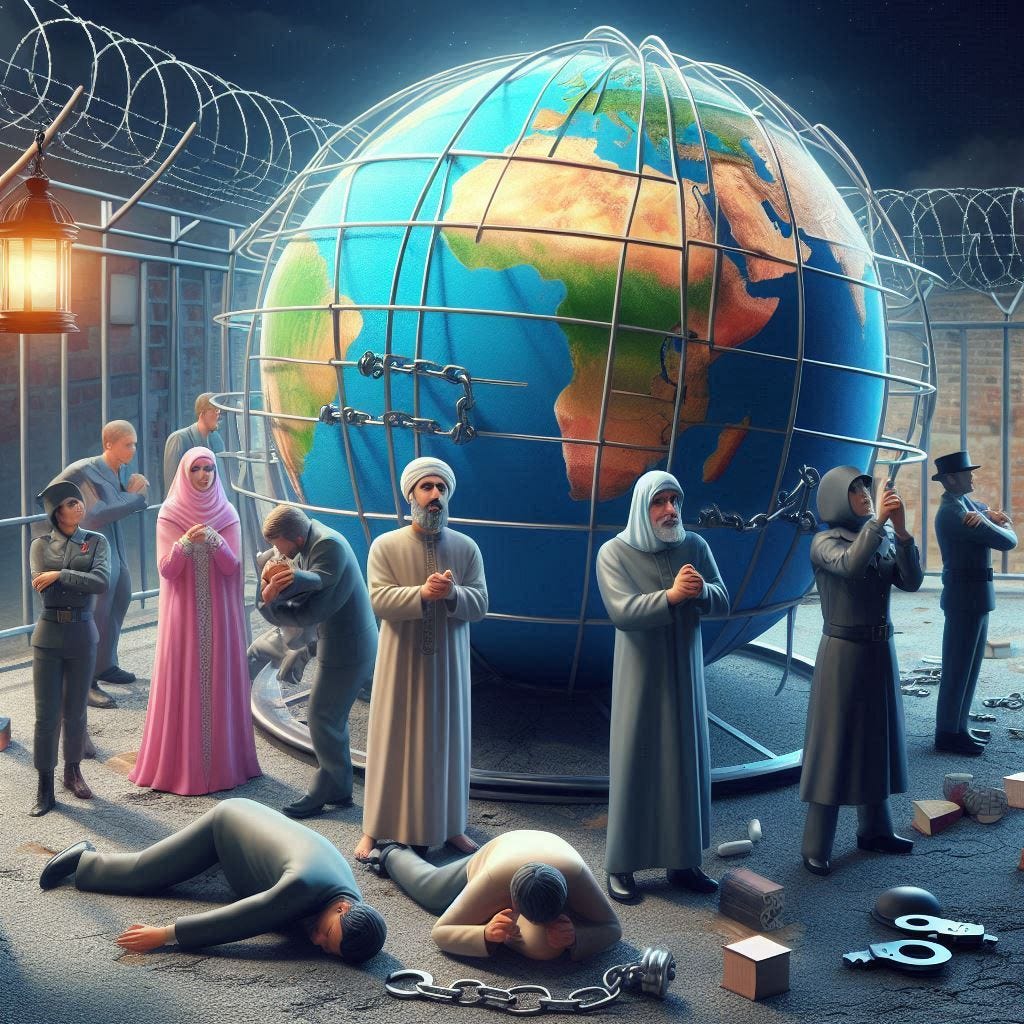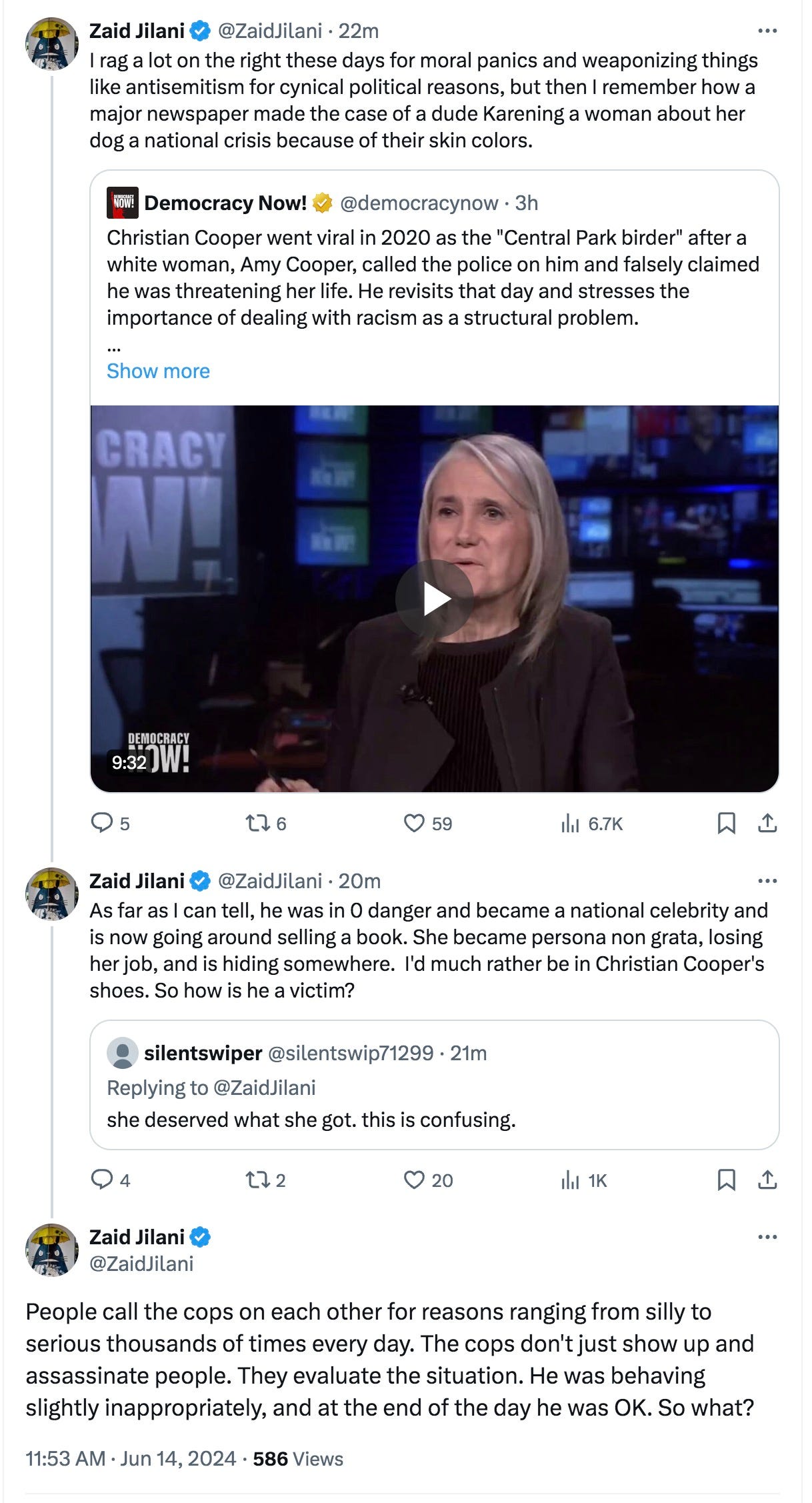E-Pluribus | June 14, 2024
Evidence? Who needs it? The secretly recorded (and rather anodyne) comments of Justice Alito; and religion under assault worldwide.
A round-up of the latest and best musings on the rise of illiberalism in the public discourse:
Leor Sapir, Joseph Figliolia: Casting Evidence Aside
Despite a growing body of scientific evidence documenting the harm done in the youth gender medicine field as currently practiced, the Biden administration plowed ahead with its Title IX changes anyway. At City Journal, Leor Sapir and Joseph Figliolia detail how enforcement of the new rules will look.
In its recent Title IX guidance, the U.S. Department of Education’s Office for Civil Rights [OCR] redefines the 1972 law to ban discrimination on the basis of “gender identity” in federally funded education programs. In doing so, it showed willful disregard for scientific research on pediatric gender transition and for the findings of the Cass Review, a 388-page report and the most comprehensive to date on youth gender medicine.
[. . .]
The new rule effectively forces schools to facilitate so-called social transitions—recognizing trans-identifying students by their chosen “gender”—regardless of students’ age, familial circumstances, or medical and mental-health background. Schools won’t need to get parental consent; in fact, the rule effectively compels them to secure students’ consent before disclosing information about their social transition to their parents. It does so by recognizing students’ right to privacy from not just their school, but their own parents.
These new changes bring the Department of Education into conflict with the findings and recommendations of the recently published Cass Review. Immediately following the Review’s publication, Kamran Abbasi, editor-in-chief of the British Medical Journal, acknowledged that the evidence base for gender medicine—“from social transition to hormone treatment”—is “threadbare.” He called the report “an opportunity to pause, recalibrate, and place evidence informed care at the heart of gender medicine.”
The Biden administration has declined that opportunity. Its new Title IX rules implicitly reject the report’s findings and further illustrate Democrats’ indifference to the rising chorus of international skepticism about pediatric gender medicine and early social transition.
[. . .]
The new regulations will force schools to accommodate a student who requests social transition, regardless of the student’s age, level of cognitive and emotional maturity, family circumstances, or mental-health challenges, and with or without a mental-health professional’s diagnosis or input from parents. Notably, the rules favorably cite two policy documents—an advisory from the California DOE and an administrative regulation from Nevada’s Washoe County School District—that endorse blanket social transition policies at school without requiring parental notification.
[. . .]
Following OCR’s logic to its conclusion, a school with a parental-notification policy could be guilty of “hostile environment harassment,” as defined in the new Title IX regulations. After all, some would argue, such a policy could be “subjectively and objectively offensive and . . . so severe or pervasive that it limits or denies a person’s ability to participate in or benefit from the recipient’s education program or activity.” Indeed, though the regulatory update goes into effect in August, the Office for Civil Rights has already cited this rationale to launch an investigation against a school district for its parental-notification policy.
The Biden administration, in its Title IX guidance and elsewhere, has stretched the term “abuse” beyond its obvious connotation to include failing to “affirm” a child’s gender identity. Proponents of the administration’s position claim that trans-identified students are at high risk of rejection and could face abuse at home if they are “outed” to their families, but we’ve noted serious problems with this argument. In effect, so has England’s National Health Service, which recommended last September that fit parents should always be involved in the decision-making process regarding social transition in school.
Read it all here.
Marc O. DeGirolami: What Exactly Did Justice Alito Say That Was Wrong?
Despite the unethical methods employed, the New York Times and other news organizations jumped at the chance to write stories about the (allegedly) shocking comments made in secretly recorded conversations in which a progressive activist lied to Justices Alito and Roberts to try to embarrass them. In an opinion essay, also at The Times, Marc DeGirolami, asks, what’s the big deal, anyway?
Justice Samuel Alito has been widely criticized this week for remarks he made to a self-described documentary filmmaker who on two occasions engaged him at social events, secretly taped him under false pretenses and released the recordings. What did he say that was wrong?
Nothing. None of his remarks was improper for a judge to make. Furthermore, he did not even say anything especially controversial — or at least nothing that would be controversial in a less polarized moment.
[. . .]
In perhaps the most discussed exchange, he assented to the filmmaker’s statement that it is important to win “the moral argument” and “return our country to a place of godliness.”
To start with the question of judicial ethics: Where was the justice’s error? He did not mention any pending case or litigation. He did not name any person or party. He did not discuss any specific political or moral matter. Most of the exchange consists of the filmmaker’s own goading remarks, followed by the justice’s vague and anodyne affirmations and replies. About what you might expect when cornered at a boring cocktail party.
Setting aside judicial ethics, I can think of two possible objections to what Justice Alito said: that he should not hold these views; or that he should not express them in public.
As to whether he should hold these views, I would suggest that they are not so extreme as to merit denunciation. On the contrary, they are reasonable, even commonplace.
[. . .]
[M]any people in this country do believe in God and godliness. Many believe in the truth of our national motto, “In God We Trust.” They think religion contributes to a kinder and more moral society. And many of these people — including Justice Alito, to judge from his brief assent on the recording — also think that greater godliness might help the nation today. Americans who think God has something to teach us about decency and love and moral rectitude would be surprised to hear that treated as a shocking or extremist view.
Read it all.
Doug Bandow: Rising Restrictions on Religion Driven by Government Controls
Despite the efforts of some to weaken First Amendment protections, religious freedom in the US remains robust, if imperfect. Writing at The American Conservative, however, Doug Bandow reports that many around the world are not so fortunate, and governmental restrictions are only getting worse.
In 2021, 183 governments, the most ever, harassed religious believers. In 163 countries, down just one from 2020, governments interfered with worship. Examples of the latter included “policies or actions that disrupt religious gatherings, deny permits for religious activities, bar access to places of worship, and restrict other rituals.” Covid restrictions played an important role. The comparable numbers from 2007 were dramatically lower: 118 and 112, respectively. Overall, attacks on religious believers were up more than 50 percent in both categories.
In 55 countries, government restrictions were either high or very high. That was down two from 2019–2020, the peak only previously reached in 2012. The lowest bound was a still significant 40 nations, set in 2007. The median score increased in 2021 since there were more increases than decreases among individual index scores.
Reflecting the variable and even paradoxical nature of religious persecution, government restrictions and social hostility do not necessarily correlate. The former tend to be consistent, increasing generally steadily over time, from 1.8 in 2007 to 3.0 in 2021. Social attitudes are more volatile, starting at 1.0 in 2007, peaking at 2.1 in 2017, and dropping to 1.6 in 2021.
State controls over religion were highest in China, which had the world’s second-lowest social hostility measure. The driving force for persecution there is political, fear of competition for influence, and especially of transcendent truths which trump the Chinese Communist Party’s claim to power. The situation has worsened dramatically over the last decade, as CCP General Secretary Xi Jinping has greatly strengthened the party’s authority and his own.
[. . .]
It also is worth noting the best states. Japan, Democratic Republic of Congo, South Africa, the Philippines, and the United States of America had the fewest restrictions. Enjoying lowest social hostility were Japan, China, the U.S., Turkey, and South Africa. Best in the combined category were Japan, America, South Africa, Italy, and Brazil. Even these are not perfect, of course. Tokyo has targeted members of the Unification Church and Jehovah’s Witnesses.
The only good news from the Pew study is that there are countries where believers are free to respond to the transcendent as they, rather than the state or the majority, desire. Notable is America’s place on that list. Still, even American believers have reason for concern. The authoritarian left is increasingly willing to sacrifice religious liberty as it campaigns to remold and remake Americans, using the state to punish Christians who resist wokedom’s latest social dictates. Nevertheless, support for treating faith as the first freedom remains high and institutional protections for freedom of conscience remain strong. What occurs in the U.S. is not persecution.
Read the whole thing.
Around Twitter (X)
Here’s Zaid Jilani with some thoughts about the “Central Park birder” incident from 2020. Below are the first 3 tweets in an extended thread:
Via Wesley Yang, California continues to eat away at parental rights:
And finally, via Jonathan Levine, a big OOPS! from New York Magazine:










